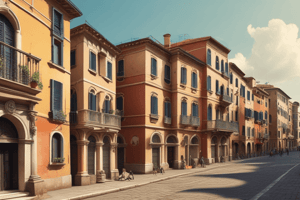Podcast
Questions and Answers
What significant festival marks the Assumption of Mary in Italy?
What significant festival marks the Assumption of Mary in Italy?
- Ferragosto (correct)
- Epiphany
- Carnival
- Sagra
Which city is recognized as a global fashion capital of Italy?
Which city is recognized as a global fashion capital of Italy?
- Venice
- Milan (correct)
- Rome
- Florence
Which type of traditional Italian music is known for its operatic background?
Which type of traditional Italian music is known for its operatic background?
- Jazz
- Folk Music
- Opera (correct)
- Pop
Which key ingredient is essential in traditional Italian cuisine?
Which key ingredient is essential in traditional Italian cuisine?
Who is a prominent artist associated with the Baroque period in Italy?
Who is a prominent artist associated with the Baroque period in Italy?
What is a well-known traditional folk dance from Italy?
What is a well-known traditional folk dance from Italy?
What is the traditional dish recognized as the origin of pizza in Italy?
What is the traditional dish recognized as the origin of pizza in Italy?
Which art movement in Italy focused on speed and modernity?
Which art movement in Italy focused on speed and modernity?
Flashcards are hidden until you start studying
Study Notes
Italian Culture and Traditions
- Family Values: Central to Italian life; strong emphasis on familial bonds and gatherings.
- Festivals and Celebrations:
- Carnival: Notable in Venice; features parades and masked balls.
- Ferragosto: Celebrated on August 15; marks the Assumption of Mary and summer holidays.
- Various local festivals (sagre) celebrating food and regional traditions.
- Fashion and Design: Milan is a global fashion capital; Italian designers like Gucci, Prada, and Versace are internationally recognized.
- Music and Dance:
- Traditional music includes opera, folk music, and regional variations.
- Tarantella is a popular folk dance.
- Language: Italian is the official language; dialects vary significantly across regions.
Italian Art History
- Renaissance Era (14th-17th Century):
- Birthplace of the Renaissance; notable figures include Leonardo da Vinci, Michelangelo, and Raphael.
- Key developments in perspective, human anatomy, and realistic representation.
- Baroque Period (17th Century):
- Characterized by dramatic use of light and shadow; artists like Caravaggio and Bernini excelled.
- Modern Art (19th-20th Century):
- Movements like Futurism emerged; artists like Umberto Boccioni focused on speed and modernity.
- Architectural Heritage:
- Landmarks include the Colosseum, St. Peter's Basilica, and the Leaning Tower of Pisa.
- Numerous UNESCO World Heritage Sites, highlighting Italy's rich artistic legacy.
Italian Cuisine
- Regional Diversity: Cuisine varies by region; influences from local ingredients and historical context.
- Key Ingredients:
- Olive oil, tomatoes, garlic, and cheese are staples.
- Fresh produce, seafood, and meats vary by geographical region.
- Classic Dishes:
- Pasta: Varieties include spaghetti, lasagna, and ravioli; often served with rich sauces.
- Pizza: Originated in Naples; traditional Margherita pizza is a classic.
- Risotto: Creamy rice dish, notably risotto alla Milanese.
- Coffee Culture: Espresso is a fundamental part of daily life; other variations include cappuccino and macchiato.
- Dining Customs:
- Meals are social events; typically long and leisurely with multiple courses.
- Wine is an integral part of meals, with regional wines complementing local dishes.
Italian Culture and Traditions
- Family values are paramount in Italy, emphasizing close relationships and regular gatherings.
- Carnival in Venice is famous for its vibrant parades and elaborate masked balls.
- Ferragosto, celebrated on August 15, honors the Assumption of Mary and marks the peak of summer vacations.
- Local festivals, or sagre, showcase regional foods and traditions throughout Italy.
- Milan is recognized as a global fashion hub, home to renowned designers such as Gucci, Prada, and Versace.
- Italian music features genres like opera and folk, with the Tarantella being a notable traditional dance.
- The official language is Italian, with significant regional dialects influencing local communication.
Italian Art History
- The Renaissance (14th-17th Century) began in Italy, highlighting artists like Leonardo da Vinci, Michelangelo, and Raphael, and fostering advancements in perspective and human anatomy.
- The Baroque period (17th Century) is marked by artists such as Caravaggio and Bernini, known for their dramatic use of light and shadow.
- Modern art movements like Futurism, pioneered by artists such as Umberto Boccioni, emerged in the 19th and 20th centuries, focusing on themes of speed and modernity.
- Italy boasts iconic architectural landmarks, including the Colosseum, St. Peter's Basilica, and the Leaning Tower of Pisa.
- Numerous UNESCO World Heritage Sites affirm Italy's rich and diverse artistic heritage.
Italian Cuisine
- Italian cuisine exhibits strong regional diversity, shaped by local ingredients and historical influences.
- Staple ingredients include olive oil, tomatoes, garlic, and various cheeses, while each region offers unique produce, seafood, and meats.
- Classic dishes feature a variety of pasta, such as spaghetti and ravioli, often accompanied by rich sauces.
- Pizza originated in Naples, with the traditional Margherita pizza being widely celebrated.
- Risotto, particularly risotto alla Milanese, is a creamy rice dish emblematic of northern Italian cuisine.
- Coffee culture places a significant focus on espresso, with variations like cappuccino and macchiato being popular.
- Dining customs reflect the social nature of meals, often involving multiple courses and leisurely gatherings, with wine pairing integral to the dining experience.
Studying That Suits You
Use AI to generate personalized quizzes and flashcards to suit your learning preferences.




